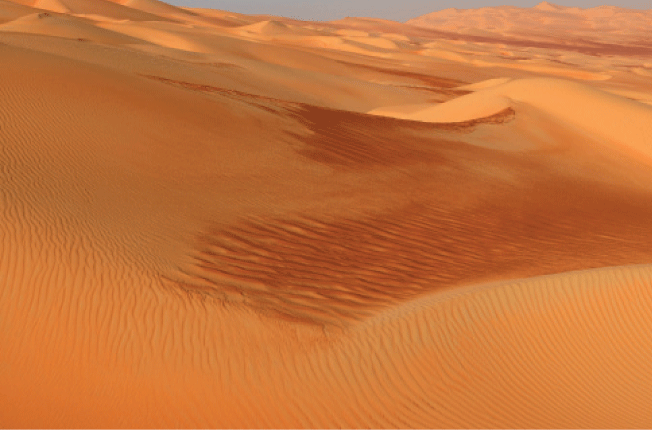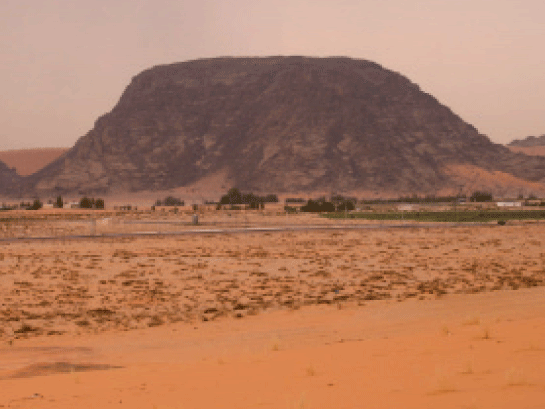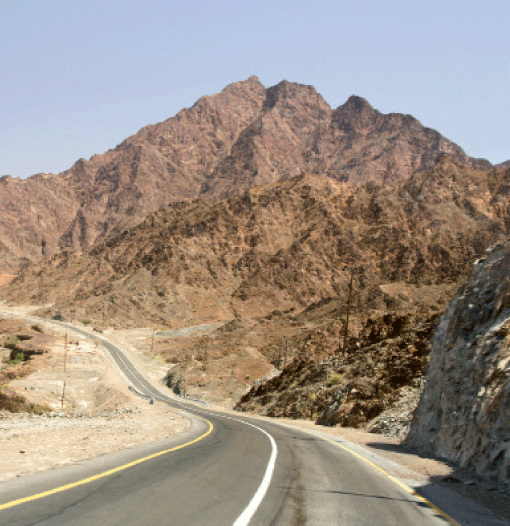
THE EMPTY QUARTER
DESERT OUTINGS
 |
A drive through the edge of Rub Al-Khali You don't need an SUV for this desert drive.
Take the Al-Kharj road to the Saudi-UAE border and you'll find yourself driving right through
a section of one of the largest, harshest deserts of the world.
By: Vinod Menon
A weekend motoring getaway from Riyadh would usually mean a four-hour drive to Al-Khobar and a swift drive across the causeway to Bahrain. But for the adventurous motorist in Riyadh, there's an almost obscure driving destination waiting to be explored – the long, but straight road to the UAE border through Al-Kharj.
This little used, 500-km road between Riyadh and the UAE border cuts the driving time from Riyadh to the border by nearly two hours. The road rolls out from eastern Riyadh through Al-Kharj and extends to Haradh on a straight, lonesome highway all the way to the UAE border post of Al-Batha. After a pleasant five-hour drive from Riyadh to the border, another four hours on the UAE side will take you to Abu Dhabi, and yet another hour-and-a-half to Dubai.
Rarely does one get the opportunity to see the raw desert from such close quarters – while not off-roading. The road to Al-Batha cuts partly right through the edge of the Rub Al-Khali (Empty Quarter), and sand dunes are right there at your doorstep. You'll find sand drifting on to the highway, swept back by laborers on backhoes, toiling endlessly throughout the length of the highway. And the best of it all is you can enjoy this desert drive with your kids as well, unlike in a macho desert expedition.
It was pre-dawn, around 4.30 am, as we (family and I) left our Riyadh home, well stocked with munchies for the Rub Al-Khali crossing, as it were. A staid hours' drive took us to Al-Kharj where we refilled for the long desert drive.
After a left turn at the water tower traffic lights, follow the road leading to Haradh, another two hours away, where a gas/oil project has sprung right in the midst of the barren desert. The next half-hour or so is a lackluster drive through industrial surroundings, including the Almarai and Al-Safi dairy farms.
As you speed past a few abandoned fuel stations and featureless landscape, it would soon seem to be the end of life itself. An occasional milestone would indicate the nearest outpost of civilization to be around 100 kms at Haradh. Goods trucks, and an occasional SUV, are the only signs of activity. Was it really wise to come down this road?
Yes, surely it was, as the raw beauty of the desert soon sets in. The beautiful desert landscape was far from the Rub Al-Khali image of a harsh and alienating expanse. In fact it felt gentle and inviting. A halt along the dirt road after a couple of hours of driving would add to the joy. The enthusiast could look around for specimens of plants, rocks and various forms of desert life.
The breathtaking sand dunes are in their rawest form, untouched by man – except for the sand spilling on to the asphalted road. Here's where you'll find the laborers on their machines relentlessly engaged in sweeping back the sands to where they belong.
Fuel stations are few on the way and only the '91' variety is available. But a full tank at Al-Kharj should take you to Al-Batha, the UAE border. 
Unlike the Riyadh-Dammam or the Riyadh-Jeddah expressways, the road to Al-Batha is not fenced. And it needn't be. The harsh conditions of the Rub Al-Khali being what it is, there is no real danger of camels scurrying across the road. Historically, the desert has rarely been inhabited. Even nomadic Bedouins are believed to have chalked out routes well around the parameters of the Quarter.
The average summer temperatures are said to rise to as much as 55 degrees centigrade. That's where the little luxuries of life come handy. Of course, we're referring to our air-conditioner that kept us fresh and cool as we drove, leaving us in awe to lap up the desert splendor outside.
But the extreme temperatures of the Rub Al-Khali do not, surprisingly, deter the various species of birds, plants and insects. While little plants or shrubs may be visible all along, and an insect or two may be spotted during stops, birds are a rarity. If you're lucky, you might just about spot some near Haradh – that only major sign of civilization en route.
Haradh, located at the southern tip of the Ghawar oil field, is a government-run facility. Not much is seen though, as you drive past, except for some distant activity. Our hearts went at once to the people toiling at the facility. Where do they go for that quick McDonald's bite, or for a quick mall run, or even a simple stroll by the sea? But then, here we were enjoying every bit of the emptiness, overwhelmed by the awesome fact that we are really passing through the edges of the mighty Rub Al-Khali.
As we leave Haradh, and a couple of hours later, the splendor of the Empty Quarter soon fades, as we spot the Salwa-Batha road forming a 'T' at a distance. Land ahoy, yelled my son!
And why haven't many motorists ventured out on this scenic road? The dread of driving on such a forlorn road is what most say. Yes, the route may be lonely of private motorists, but not of expat truckers. Help is always at hand to fix that flat. All in all, if your vehicle is road worthy, there is simply no reason why you shouldn't hit it for an on-road drive through the Rub Al-Khali. It's definitely worth the experience.